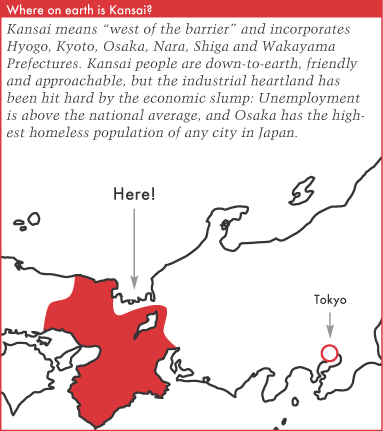Oodles of Noodles for the Mobile Masses
Back to Contents of Issue: June 2003
|
|
|
|
by Dominic Al-Badri |
|
 MY FAVORITE STORY ABOUT Japan's premier contribution to the world of fast food, the instant noodle, concerns a 20 year-old university student in the northern city of Sendai. Away from the bosom of his family -- and his doting mother's home-cooking -- for the first time, the young man had been at a loss as to how to feed himself. Not knowing any better, he took to munching his favorite school day snack, the polystyrene pots of instant noodles commonly known as "cup ramen," on a regular basis. He was so fond of the noodles' convenience that he took to eating them not just every day, but every mealtime. Eighteen months later, the story goes, he was admitted to the hospital for severe malnutrition. His skin had taken on a hue normally found in sufferers of jaundice, his very flesh turning the distinctive yellowy-brown color of a particular brand of popular curry-flavored noodles, which had been his favorite. MY FAVORITE STORY ABOUT Japan's premier contribution to the world of fast food, the instant noodle, concerns a 20 year-old university student in the northern city of Sendai. Away from the bosom of his family -- and his doting mother's home-cooking -- for the first time, the young man had been at a loss as to how to feed himself. Not knowing any better, he took to munching his favorite school day snack, the polystyrene pots of instant noodles commonly known as "cup ramen," on a regular basis. He was so fond of the noodles' convenience that he took to eating them not just every day, but every mealtime. Eighteen months later, the story goes, he was admitted to the hospital for severe malnutrition. His skin had taken on a hue normally found in sufferers of jaundice, his very flesh turning the distinctive yellowy-brown color of a particular brand of popular curry-flavored noodles, which had been his favorite.
Calorie-packed The tale cuts to the heart of a modern phenomenon regarding the increasing dependence on convenience food, not just in Japan, but worldwide, a dependence that has firm roots right in the heart of Kansai. In the drab suburban city of Ikeda, a few miles northwest of regional powerhouse Osaka, the very first instant noodle was unleashed on an unsuspecting world by the food manufacturing company Nissin in August 1958. Kansai citizens are well known for their love of good food -- the best in the country, say some -- and also their love of money. Combining the two was precisely what Ando Momofuku had in mind when he came up with what was soon dubbed "Miracle ramen" by a Japanese press hungry for homemade heroes after the devastation of World War II. "Miracle ramen" Ramen had experienced an explosion in popularity after the end of the War; the calorie-packed noodles in a hot bowl of broth were a favorite with cash-conscious workers at lunchtimes and in the evenings. Seeing the long lines outside ramen joints and noodle stands, Ando came up with an easy-to-cook ("Just add boiling water and wait two minutes!"), dried version that could swiftly be rustled up at home. Though hardly what one could call "gourmet," or even "food," Chikin (chicken) Ramen was a smash hit with Kansai noodle fans and people of all ages across the nation. With Morinaga's introduction of instant coffee to Japan two years later, the 1960s were set to be the "Instant Decade." Osaka-based Nissin soon found itself one of literally hundreds of companies churning out all manner of instant noodles. Within three years of their introduction, in 1961, 550 million packets were being sold annually nationwide; four years later this had increased fourfold to 2.5 billion.
Global domination
Salt-flavored noodles (shioaji no tanmen), dried, fried noodles (yakisoba) and regional specialties like Nagasaki tanmen were just a few of the innovations Nissin and other manufacturers developed in order to keep customers slurping away. Nissin, faced with declining noodle sales on the home front in the late 1960s, made two critical decisions to secure its future. The first was to take the noodles global, a process it started in 1970 by introducing them to the USA. Nissin now has 25 factories in nine countries, and major markets include China and Brazil. But Nissin's most brilliant decision was to put the noodles in a heat-resistant, polystyrene container -- and make them mobile. The Cup Noodle, which hit the market in 1971, was a runaway success: It liberated the noodles from the saucepan, which meant they could be enjoyed anywhere hot water was available, be it a baseball park, outdoor vending machine or mama's thermos bottle at the family picnic. The ultimate symbol of the noodle's successful bid for global domination is the giant Cup Noodle billboard that has towered as an icon over New York's Times Square since the summer of 1996. For the most part, the instant noodle has been accepted throughout Asia, the Americas and the Middle East, and is particularly relished in China, Thailand, Korea and the Philippines. The further west one goes, however, the less popular it is, with the whole of Europe barely eating 1/15th of the number of packets Japan now slurps through annually (400 million vs. 5.2 billion servings). Unsurprisingly, European bastions of fine cuisine like France, Italy and Spain have little or nothing to do with Japan's most representative convenience food, while the continent's poorest relations -- in terms of food, at least -- namely Britain and Ireland, have the highest per capita consumption. Some 600 new varieties hit Japanese store shelves each year, and manufacturers are constantly searching for attention-catching combinations. One recent surprise smash has been the introduction of instant noodles "branded" with the name of a famous noodle shop, like Ippudo in the western city of Fukuoka. Introduced by Nissin in 2000, sales of this and another co-branded product rocketed to over 17 million packages (at JPY250 each) in just over a year. Shoppers were happy to pay a premium price, if only for the illusion of eating a premium noodle.
Lord Noodle
In the shadow of industrial giant Osaka, little Ikeda city, Ando's hometown, doesn't have much to be proud of. This is reflected in the undue attention brought to Ando himself. Aside from the attractive stone-and-glass Instant Ramen Museum in the city -- usually full of elementary school children making their own instant ramen or tripping out to a bizarre history-of-the-noodle video presentation -- there is also a stone monument to Lord Noodle in front of Ikeda City Hall. Somewhat preposterously, it proclaims Ikeda "City of Invention," and announces: "In 1958 Ando Momofuku invented instant noodles here in Ikeda, and changed the food culture of the world." Change it, he did; but for the better? @
|
|
Note: The function "email this page" is currently not supported for this page.






